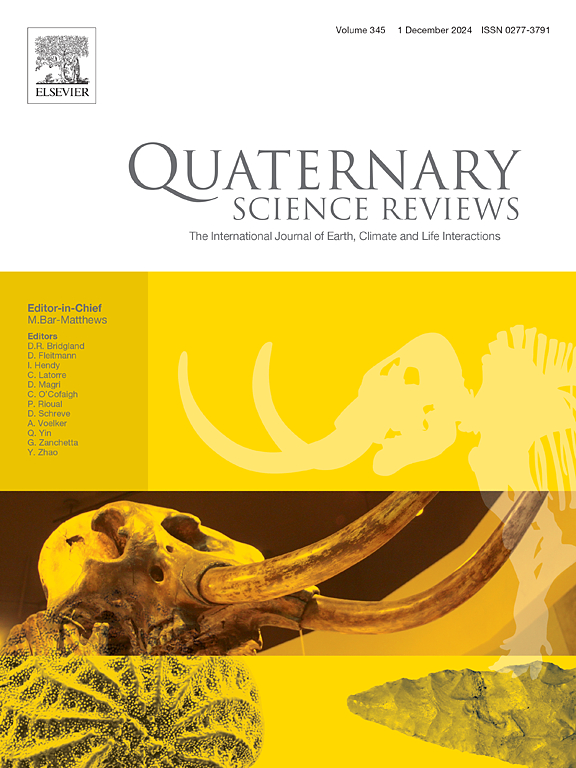中更新世过渡后,湖泊浅层生物气生产与气候强迫有机质埋藏增加有关
IF 3.3
1区 地球科学
Q1 GEOGRAPHY, PHYSICAL
引用次数: 0
摘要
华北河套盆地第四纪沉积以河湖沉积为主,生物气广泛发育。然而,生物气源岩有机质聚集和保存的控制因素尚不清楚,中更新世过渡对有机质的潜在影响有待进一步研究。通过伽马射线(GR)、铷锶比(Rb/Sr)、平均粒度、总有机碳(TOC)、总氮(TN)和有机碳稳定同位素(δ13Corg)的分析,结合光激发发光(OSL)和电子自旋共振(ESR)测年,建立了200万年的天文时间尺度,探讨了MPT对OM积累和保存的影响。结果表明:1)湖泊沉积物的GR、Rb/Sr和平均粒度资料记录了约1.1 ~ 0.75 Ma的MPT,其特征是主导旋回由~ 41-kyr倾角向~ 100-kyr偏心旋回转变;2)河套盆地湖泊的沉积旋回主要受冰原-气候系统动态反馈的天文强迫控制。这些周期通过对冰量和季风强度的调节,代表了轨道变化的间接气候效应;3). MPT后间冰期陆相有机质输入的增加、有利的沉积环境和冰期-间冰期旋回的延长为烃源岩有机质的聚集和保存创造了有利条件,从而为生物气形成提供了所需的输入。本文章由计算机程序翻译,如有差异,请以英文原文为准。
Lacustrine shallow biogenic gas production linked to climatically forced increase in organic matter burial following the Mid-Pleistocene Transition
The sediments in the Hetao Basin of North China during the Quaternary are dominated by fluvial-lacustrine deposition, with widespread development of biogenic gas. However, the controlling factors of organic matter (OM) accumulation and preservation in biogenic gas source rocks remain unclear, and their potential influence by the Mid-Pleistocene Transition (MPT) requires further investigation. This study analyzed gamma ray (GR), Rubidium strontium ratio (Rb/Sr), mean grain size, total organic carbon (TOC), total nitrogen (TN) and organic carbon stable isotopes (δ13Corg), along with optically stimulated luminescence (OSL) and electron spin resonance (ESR) dating, to establish a two million-year astronomical timescale and explore the impact of the MPT on accumulation and preservation of OM. The results indicate that: 1) The MPT at ca. 1.1 to 0.75 Ma is well recorded in the GR, Rb/Sr and mean grain size data of the lake sediments, and is characterized by a shift in the dominant cyclicity from ∼41-kyr obliquity to ∼100-kyr eccentricity cycle; 2) The sedimentary cycles of the Hetao Basin lakes were primarily controlled by astronomical forcing through dynamic feedbacks within the ice sheet–climate system. These cycles represent the indirect climatic effects of orbital variations via their modulation of ice volume and monsoon intensity; 3). After the MPT, increased input of terrestrial organic matter during interglacial periods, favorable depositional environments and the extension of glacial-interglacial cycles created favorable conditions for the accumulation and preservation of organic matter in source rocks, thereby providing the inputs required for biogenic gas formation.
求助全文
通过发布文献求助,成功后即可免费获取论文全文。
去求助
来源期刊

Quaternary Science Reviews
地学-地球科学综合
CiteScore
7.50
自引率
15.00%
发文量
388
审稿时长
3 months
期刊介绍:
Quaternary Science Reviews caters for all aspects of Quaternary science, and includes, for example, geology, geomorphology, geography, archaeology, soil science, palaeobotany, palaeontology, palaeoclimatology and the full range of applicable dating methods. The dividing line between what constitutes the review paper and one which contains new original data is not easy to establish, so QSR also publishes papers with new data especially if these perform a review function. All the Quaternary sciences are changing rapidly and subject to re-evaluation as the pace of discovery quickens; thus the diverse but comprehensive role of Quaternary Science Reviews keeps readers abreast of the wider issues relating to new developments in the field.
 求助内容:
求助内容: 应助结果提醒方式:
应助结果提醒方式:


